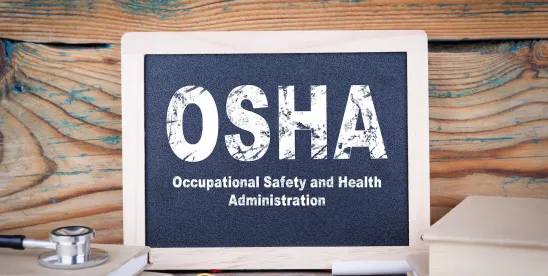On April 13, 2020, in response to the ongoing global pandemic caused by SARS-CoV-2 (the novel coronavirus), the Occupational Safety and Health Administration (OSHA) issued much-anticipated interim enforcement guidance (the “Interim Guidance”).[1] While the Interim Guidance provides “instructions and guidance to Area Offices and compliance safety and health officers for handling COVID-19-related complaints, referrals, and severe illness reports,” it contains valuable insights for employers regarding OSHA’s enforcement priorities, which, at present, largely focus on the healthcare industry.
Workplace Risk Levels: OSHA Identifies Certain Health Care Employees and First Responders at Highest Risk for Coronavirus Exposure
In approaching its enforcement priorities during the coronavirus pandemic, OSHA states that it will identify risk levels in workplace settings. The risk levels, of which there are three, are the same as those used in the Occupational Risk Pyramid outlined in the OSHA publication, Guidance on Preparing Workplaces for COVID-19:
-
High-risk and very-high-exposure-risk jobs “are those with high potential for exposure to known or suspected sources of SARS-CoV-2 that occurs during specific medical, postmortem, or laboratory procedures.”
-
Medium-exposure-risk jobs “include those with frequent and/or close contact with, i.e., within 6 feet of, people who may be (but are not known to be) infected with SARS-CoV-2 . . . includ[ing], but not limited to, those who have contact with the general public (e.g., in schools, high-population-density work environments, and some high-volume retail settings).”
-
Lower-exposure-risk jobs “are those that do not require contact with people known to be, or suspected of being, infected with SARS-CoV-2, nor frequent close contact with, i.e., within 6 feet of, the general public. Workers in this category have minimal occupational contact with the public and other coworkers.”
OSHA Prioritizes Onsite Inspections for Healthcare Employers and Phone/Fax Inspections for All Other Employers
OSHA clarifies that fatalities and imminent danger exposures related to COVID-19 will be prioritized for inspections, with particular attention given to healthcare organizations and first responders. OSHA further states that “during this outbreak, formal complaints alleging unprotected exposures to COVID-19 for workers with a high/very high risk of transmission, such as a fatality that is potentially related to exposures to confirmed or suspected COVID-19 patients while performing aerosol-generating procedures without adequate [personal protective equipment (PPE)] in a hospital, may warrant an on-site inspection.”
The Interim Guidance makes clear that where employees are engaged in medium or lower exposure risk jobs, OSHA will conduct a “non-formal phone/fax” inspection. This is significant because it means that the majority of COVD-19 related-complaints and referrals will not involve an on-site inspection. However, where an employer’s response is “inadequate,” OSHA may choose to open an on-site inspection in accordance with its guidelines. Employer-reported hospitalizations will be handled using the rapid response investigation (RRI) procedure as outlined in the OSHA Memorandum on RRIs dated March 4, 2016.
Healthcare Employers Must Continue to Comply With Their Record Keeping Obligations Under OSHA’s New Enforcement Priorities
On April 10, 2020, OSHA issued Enforcement Guidance for Recording Cases of Coronavirus Disease 2019 (COVID-19). The guidance clarifies that under OSHA’s recordkeeping requirements, found at 29 CFR Part 1904, COVID-19 is a recordable illness, and employers are responsible for recording cases of COVID-19, if:
-
the case is a confirmed case of COVID-19, as defined by Centers for Disease Control and Prevention (CDC);
-
the case is work related as defined by 29 CFR § 1904.5; and
-
the case involves one or more of the general recording criteria set forth in 29 CFR § 1904.7.
Notably, OSHA states that it will enforce Part 1904 as to “employers of workers in the healthcare industry, emergency response organizations (e.g., emergency medical, firefighting, and law enforcement services), and correctional institutions,” but that it will “not enforce 29 CFR § 1904 to require other employers to make the same work-relatedness determinations,” except where:
-
There is objective evidence that a COVID-19 case may be work related. This could include, for example, a number of cases developing among workers who work closely together without an alternative explanation; and
-
The evidence was reasonably available to the employer. For purposes of this memorandum, examples of reasonably available evidence include information given to the employer by employees, as well as information that an employer learns regarding its employees’ health and safety in the ordinary course of managing its business and employees.
Other Applicable Standards
The Interim Guidance highlights that the majority of complaints OSHA has received during the initial months of the SARS-CoV-2 outbreak describe concerns related to lack of PPE, such as respirators, gloves, and gowns, concerns about a lack of training on appropriate standards, and possible COVID-19 illnesses in the workplace. This information is helpful to employers because it is indicative of the types of violations OSHA will enforce. Moreover, while OSHA has not issued a rule that specifically addresses how to control hazards posed by COVID-19 or other airborne diseases, the Interim Guidance includes a nonexhaustive list of the standards OSHA is most likely to cite for hazards posed by COVID-19, including:
-
29 CFR § 1904, Recording and Reporting Occupational Injuries and Illness.
-
29 CFR § 1910.132, General Requirements – Personal Protective Equipment.
-
29 CFR § 1910.133, Eye and Face protection.
-
29 CFR § 1910.134, Respiratory Protection.
-
29 CFR § 1910.141, Sanitation.
-
29 CFR § 1910.145, Specification for Accident Prevention Signs and Tags.
-
29 CFR § 1910.1020, Access to Employee Exposure and Medical Records.
The Interim Guidance provides that these “standards and requirements should be evaluated for high to very high occupational exposure risk as defined in this memorandum.” Because health care employers employ workers with “high risk and very high” exposure risk jobs, they in particular should focus on ensuring compliance with these standards.
In addition to the standards listed above, employers are also required to comply with the general-duty clause of the Occupational Safety and Health Act, which involves providing a place of employment “free from recognized hazards that are causing or are likely to cause death or serious physical harm to . . . employees.”[2] OSHA’s Interim Guidance at Attachment 1 directs compliance safety and health officers to follow its citation procedures for issuing a general duty violation if “deficiencies not addressed by OSHA standards or regulations are discovered in the employer’s preparedness for controlling high to very high occupational exposure risk for SARS-CoV-2, and guidance is available from the CDC.”
OSHA’s Hazard Alert Letter Is a Compliance Roadmap for Employers
In situations where the investigation does not support a general-duty-clause violation—for example, where there is “no clear evidence that an employee was exposed to the virus in the workplace”—OSHA may issue an employer a Hazard Alert Letter (HAL). A HAL is not a citation. The Interim Guidance, includes a sample HAL.[3] The HAL is instructive because it outlines specific engineering and administrative controls, personal protective equipment, and training and information that OSHA recommends. In the HAL, OSHA recommends employers implement the following, among other things:
-
Use airborne infection isolation rooms to reduce the spread of the SARS-CoV-2 virus when performing aerosol-generating procedures such as bronchoscopy, sputum induction, endotracheal intubation and extubation, open suctioning of airways, cardiopulmonary resuscitation, and autopsies.
-
Develop measures to support expeditious triage and isolation (or cohorting) of suspected or confirmed COVID-19 patients to minimize unprotected employee exposure. Provide dedicated patient-care equipment for suspected or confirmed COVID-19 patients.
-
Use eye and face protection if sprays or splatters of infectious material are likely. Goggles and a half-face respirator, or a full-face respirator, should be worn while performing aerosol-generating procedures. Use of a full-face shield in front of a respirator may also prevent bulk contamination of the respirator.
-
Provide training, education, and informational materials about the risk of SARS-CoV-2 exposure associated with workers’ job tasks and activities.
While this list and the list OSHA provides are nonexhaustive, they do provide specific compliance steps health care employers can take to ensure compliance with the Occupational Safety and Health Act.
Program and Document Review
Given the hazards associated with SARS-CoV-2, OSHA has directed compliance officers to conduct portions of the agency’s inspections remotely, including program and document review. The Interim Guidance specifically lists documents and procedures compliance safety and health officers may seek prior to an on-site inspection.[4]
Based on this list, as best practices, health care employers should consider ensuring that they have the following in place:
-
A written pandemic plan as recommended by the CDC.
-
Procedures for hazard assessment and protocols for PPE use with suspected or confirmed COVID-19 patients.
-
Laboratory procedures for handling specimens and procedures for decontamination of surfaces.
-
A respiratory-protection program and any modified respirator policies related to COVID-19 and ensured compliance with 29 CFR § 1910.134.
-
Maintenance of employee training records, including any records of training related to COVID-19 exposure prevention or in preparation for a pandemic, if available.
-
Maintenance of documentation of provisions made by the employer to obtain and provide appropriate and adequate supplies of PPE.
-
Recordkeeping requirements as required by 29 CFR Part 1904.
-
Policies for assigning patients to those rooms/areas and procedures to limit access to those rooms/areas only by employees who are trained and adequately outfitted with PPE.
-
Policies in place for transferring patients to other facilities in situations where appropriate isolation rooms/areas are unavailable or inoperable. Also, the review of procedures for transferring COVID-19 patients from other facilities.
-
Policies regarding the numbers and placements, i.e., room assignments or designated area (cohorting) assignments, of confirmed and suspected COVID-19 patients under isolation at the time of inspection.
Key Considerations
The Interim Guidance makes clear that OSHA is focusing its enforcement resources, and specifically its inspection resources, on protecting health care employees and emergency responders. In order to maintain their compliance obligations under the Occupational Safety and Health Act and help to avoid potential citations, health care employers should consider the following:
-
Ensuring that they are complying with recordkeeping and reporting obligations under Part 1904;
-
Implementing the engineering, administrative, and PPE controls listed in the HAL as well as meeting training requirements; and
-
Maintaining and implementing the policies and procedures as listed above.
Finally, all employers should ensure that they are taking the following CDC-recommended steps to prevent the spread of COVID-19:
-
Actively encourage sick employees to stay home.
-
Accommodate employees through social distancing or telework (if possible).
-
Emphasize respiratory etiquette and hand hygiene by all employees.
-
Perform routine environmental cleaning.
-
Check government websites (CDC, state department) for any travel advisories (where applicable).
-
Plan for infection disease outbreaks in the workplace.
Notes:
[1] OSHA, Interim Enforcement Response Plan for Coronavirus Disease 2019 (COVID-19) (Apr. 13, 2020), https://www.osha.gov/memos/2020-04-13/interim-enforcement-response-plan-coronavirus-disease-2019-covid-19.
[2] 29 U.S.C. § 654(a)(1).
[3] See OSHA, Interim Enforcement Response Plan for Coronavirus Disease 2019 (COVID-19) (Apr. 13, 2020) at Attachment 3, https://www.osha.gov/memos/2020-04-13/interim-enforcement-response-plan-coronavirus-disease-2019-covid-19#attach3.
[4] OSHA, Interim Enforcement Response Plan for Coronavirus Disease 2019 (COVID-19) (Apr. 13, 2020), at Attachment 1, https://www.osha.gov/memos/2020-04-13/interim-enforcement-response-plan-coronavirus-disease-2019-covid-19#attach1.




 />i
/>i
